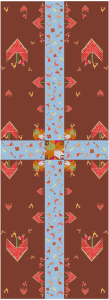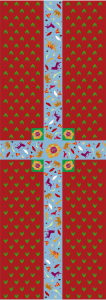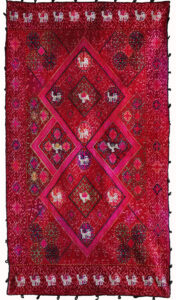Wardah Naeem Bukhari
- Shattered Tranquility
- Women Situations and Reinterpretation of Phulkari Baghs
- Eco of Life
- Aesthetic Hybridity in Mughal
- Monotony of Life
- Body in space
- Love Thy Neighbour
- Braiding the seen and unseen
- Suppression of sexuality
- Self-Obsessed
- Titles
- Events that Effected
- Space within space
- Pattoli jewelry design
- Traditional practice of pattoli craft
Eco of Life work displayed at Fakir Khana Museum, Lahore
The term “flower work,” or phalkari, describes the elaborate floral patterns and designs found in textiles. The rich cultural tapestry of Punjab in the subcontinent, where colorful threads weave narratives of tradition, spirituality, and connectedness to the natural world, is the foundation of Phulkari Baghs’ art. The deep ecological significance of Phulkari embroidery is concealed within its beautiful appearance. To depict ecology, the significance of birds and animals in Phulkari embroidery is explored and highlighted in this work. We can understand the ecological knowledge ingrained in this traditional expertise by exploring the significance of birds and animals in Phulkari embroidery. This project intends to promote Phulkari’s eco-friendly themes in our culture through Phulkari patterns and appreciate Phulkari’s artistic splendor.
This work explores the ways in which animals and birds represent life as a metaphor for the delicate ecosystems associated with waterways, drawing inspiration from the Charbagh or Chahr Bagh, an Islamic and Persian quadrilateral garden design mentioned in the Quran, which represents the Garden of Paradise and the four rivers that flow through it. In this work, I examine the ecological importance of Phulkari embroidered patterns and designs with animal and bird themes in relation to the environment and Punjabi culture.
Ecological Narratives in Jisti embroidery displayed On World Earth day, The art exhibition “Cultural Heritage at Risk: Climate Change, Museum Sustainability, and the Way Forward” was inaugurated by Ms. Nabila Irfan, Director of Lahore Museum at the Museums Art Gallery.
Through the intricate stitches of Jisti and Leekni embroidery on khaddar fabric, I aim to preserve and showcase the rich cultural heritage of Hazara Division, Pakistan. The block-printed peacock motif serves as a symbol of resilience and beauty in the face of climate change and cultural destruction. This artwork is a testament to the enduring power of traditional craftsmanship and its relevance in contemporary times.
Through this work artist intention is to preserve of cultural heritage, Impact of climate change on traditional practices, Importance of sustainability in cultural preservation and Role of art in raising awareness and promoting cultural heritage. By exploring these themes, my artwork can contribute to the broader conversation about cultural heritage and sustainability, while showcasing the beauty and significance of traditional Pakistani embroidery and textile art.
© Copyright 2024 wardahnaeembukhari.com. All rights reserved. No content on this site may be used, copied, or distributed without prior permission



